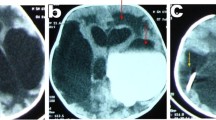Abstract
Objective
The study aims to assess the treatment of progressive multiloculated hydrocephalus. In a retrospective study, the authors reviewed their experience with different treatment modalities.
Methods
We have retrospectively evaluated 93 patients with progressive multiloculated hydrocephalus operated between 1988 and 2010. They represented around 2% (93/4,565) of all patients surgically treated for nontumoral hydrocephalus during this period of time at our institution.
Results
Ventricular septal fenestration was carried out by craniotomy in 27 patients, endoscopic septum pellucidum fenestration in 19, endoscopic ventricular septal fenestration in 18, choroid plexectomy-fulguration in 14 (8 endoscopically and 6 by craniotomy), and third ventriculostomy in 2. Hydrocephalus was resolved in 21 patients with shunting, placing two ventricular catheters as the only procedure. Out of the 72 remaining patients, 34 underwent only one treatment, 30 two treatments, and 8 three or more procedures. The majority of patients ultimately required CSF shunt placement with only one ventricular catheter.
Conclusions
(1) Multiloculated hydrocephalus is a severe disease in which no single treatment has clearly been shown to be superior. (2) The goal of treatment is to restore communication between isolated intraventricular compartments in order to create the possibility of the implantation of a simple shunt with only one intraventricular catheter. More than improving the quality of life the patient, the objective is to reduce the number of surgical procedures. (3) Given the complexity of multiloculated hydrocephalus, each patient must be studied individually, and no procedure proposed by the literature should be ruled out, no matter how old fashioned may appear.









Similar content being viewed by others
References
Spennato P, Cinalli G, Carannante G, Ruggiero C, Del Basso De Caro M (2004) In: Cinalli G, Maixner W, Sainte-Rose C (eds) Multiloculated hydrocephalus. Springer, Italy, pp 219–344
Abtin K, Walker M (1998) In: Jimenez D (ed) Endoscopic management of complex hydrocephalus. AANS Publications Committee, Rolling Meadows, pp 135–145
Nowoslawska E, Polis L, Kaniewska D, Mikolajczyk W, Krawczyk J, Szymanski W, Zakrzewski K, Podciechowska J (2003) Efectiveness of neuroendoscopic procedures in the treatment of complex compartmentalized hydrocephalus in children. Childs Nerv Syst 19:659–665
Sandberg D, Mc Comb G, Krieger M (2005) Craniotomy for fenestration of multiloculated hydrocephalus in pediatric patients. Neurosurgery 57(ONS Supp 1):ONS 100–ONS 106
Kalsbeck J, De Sousa A, Kleiman M, Goodman J, Franken E (1980) Compartmentalization of the cerebral ventricles as a sequela of neonatal meningitis. J Neurosurg 52:547–552
Eller T, Pasternak J (1985) Isolated ventricles following intraventricular hemorrhage. J Neurosurg 62:357–362
Handler L, Wright M (1978) Post meningitis hydrocephalus in infancy: ventriculography with special reference to ventricular septa. Neuroradiology 16:31–35
Schultz P, Leeds NE (1973) Intraventricular septations complicating neonatal meningitis. J Neurosurg 38:620–626
Nida T, Haines SJ (1993) Multiloculated hydrocephalus: craniotomy and fenestration of intraventricular septations. J Neurosurg 78:70–76
Oi S, Hidaka M, Honda Y, Togo K, Shinoda M, Shimoda M, Tsugane R, Sato O (1999) Neuroendoscopic surgery for specific forms of hydrocephalus. Child Nerv Syst 15:56–68
Oi S, Matsumoto S (1986) Isolated fourth ventricle. J Pediatr Neurosci 2:125–133
Oi S, Matsumoto S (1985) Pathophysiology of noneoplastic obstruction of the foramen of Monro and progressive unilateral hydrocephalus. Neurosurgery 17(6):891–896
Oi S, Kudo H, Jamada H, Kim S, Hamano S, Urui S, Matsumoto S (1991) Hydromyelic hydrocephalus correlation of hydromyelia with various stages of hydrocephalus in post-shunt isolated compartments. J Neurosurg 74:374–379
Jamjoom AB, Mohamed A, Al-Boukai A, Jamjoom ZA, Rahman N, Jamjoom HT (1996) Multiloculated hydrocephalus related to cerebrospinal fluid shunt infection. Acta Neurochir (Wien) 138(6):714–719
Albanese V, Tomasello F, Sampaolo S (1981) Multiloculated hydrocephalus in infants. Neurosurgery 8:641–646
Marquardt G, Setzer M, Lang J, Seifert V (2002) Delayed hydrocephalus after resection of supratentorial malignant gliomas. Acta Neurochir (Wien) 144(3):227–231
Aleman J, Jokura H, Higano S, Akabane A, Shirane R, Yoshimoto T (2001) Value of constructive interference in steady-state, three-dimensional, Fourier transformation magnetic resonance imaging for the neuroendoscopic treatment of hydrocephalus and intracranial cysts. Neurosurgery 48(6):1291–1295
Lewis AI, Keiper GL, Crone K (1995) Endoscopic treatment of loculated hydrocephalus. J Neurosurg 82:780–785
Mathiesen T, Grane P, Lindquist C, von Holst H (1993) High recurrence rate following aspiration of colloid cysts in the third ventricle. J Neurosurg 78(5):748–752
Spennato P, Cinalli G, Ruggiero C, Alberti F, Trischitta V, Cianciulli E, Maggi G (2007) Neuroendoscopic treatment of multiloculated hydrocephalus in children. J Neurosurg 106(1 Suppl Pediatrics):29–3
Cipri S, Gambardella G (2001) Neuroendoscopic approach to complex hydrocephalus. J Neurosurg Sci 45(2):92–96
Heilman CB, Cohen A (1991) Endoscopic ventricular fenestration using “saline torch”. J Neurosurg 74(2):224–229
Oi S, Abbott R (2004) Loculated ventricles and isolated compartments in hydrocephalus: their pathophysiology and the efficacy of neuroendoscopic surgery. Neurosurg Cli N Am 15(1):77–87
El-Ghandour NMF (2008) Endoscopic cyst fenestration in the treatment of multiloculated hydrocephalus in children. J Neurosurg Pediatrics 1:217–222
Rhoton A, Gomez M (1972) Conversion of multilocular hydrocephalus to unilocular. J Neurosurg 36:348–350
Author information
Authors and Affiliations
Corresponding author
Rights and permissions
About this article
Cite this article
Zuccaro, G., Ramos, J.G. Multiloculated hydrocephalus. Childs Nerv Syst 27, 1609–1619 (2011). https://doi.org/10.1007/s00381-011-1528-4
Received:
Accepted:
Published:
Issue Date:
DOI: https://doi.org/10.1007/s00381-011-1528-4




